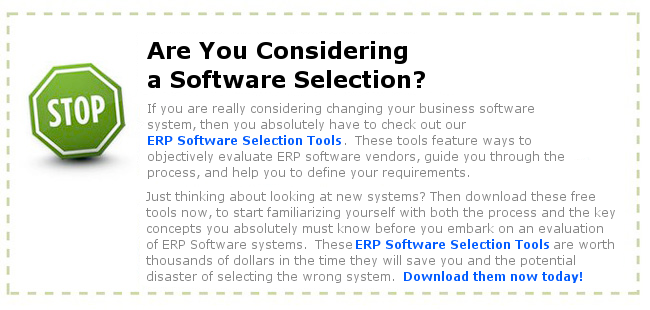ERP Software Demos – 7 Things to Watch Out For
ERP Software Demos are usually a key step in the process is evaluating ERP Software. This is usually performed by the software provider, but sometimes it is the value added reseller who demonstrates the software. There are usually two software demos provided by each vendor during the process.
The first step is an high-level demonstration of the overall look and feel of the software and it shows general functionality. This is usually to help you narrow down your list of prospective vendors.
The second ERP Software demonstration is very detailed and speaks directly to your unique software requirements. Ideally, you have provided a list of requirements and even better a demonstration script to the vendor that explains step-by-step what you want to see from the software.
We’ve compiled a list of seven items that you should watch out for when evaluating ERP software. These are common things to tune into when watching the software demonstration to ensure that you are getting to see the real software functionality in action.

ERP Software Demos – key things to watch for
1. Tell, but no show
Vendors tell you, but do not show you
One of the most often used tricks in demos is where the vendor discusses a requirement and yet does not show how the system works. You should enforce a demonstration of the methods that the software uses to fulfill the requirements. Often this maybe on oversight on the person demonstrating the software, but many times this could be a very difficult process that they don’t want to show you.
2. Unnatural fit to requirements
Vendors spend time working on getting your requirements to work in the demo but, does it feel natural that it can be done in “real life”?
Often a complex requirement can be done by the system, but it takes a number of “unnatural acts” to make it work in real life. This is a red flag for a process problem. There are two solutions, one is that you adapt the business process of the software, or two, you live with the complex processing in order to fit your business method. If you think you can live with the software process, then mark this down as a good function. If you cannot live with the software’s best practice and you must use your process, resulting in a work around method in the software, then consider this feature as a negative response to your requirement.
3. The “herky jerky” ERP Software Demo
The speed of the demo changes with certain functionality
This can be related to number 2 above. This is more a feeling to the flow of the software. An unaturally paced demonstration usually means that there are some features that the software does not do well. Sometimes it relates to your evaluating user’s questions. Be aware of the pace and determine if the unnatural flow is due to software issues or some factor in your demonstration script.
Many times the vendor will ask if they change the order of the demonstration script to fit the flow of the software. This is usually okay, so long as they have hit upon all the areas that your script requires. If you limit them to sticking strictly to your script, then you may end up with an unusual flow to your demonstration.
4. “Its in the next release!”
Vendors offer solutions that are they are not able to show
This is a classic ERP Software Demos maneuver. Your requirements cannot be fulfilled by the current revision of the software, but the vendor assures you that it is slated for the next release. According to them, this will be available by the time you go live on the software. This is often true, but keep in mind that new release features often bring bugs with them and are not as polished as older functionality. Further, you may end up being the first ones to use this new functionality. Just keep this mind and consider using this as a point of negotiation, or simply document these features for your reference so that during the implementation you can keep track of when these items will actually be released. It is not uncommon for something that is slated for next release to be bumped and postponed until a later release.
5. How can I get there from here?
Vendors fly around the screens, but there is little sense to how they are navigating
Many systems have shortcut keystrokes. You sometimes can type in a short code and the screen will jump to another window. Or, the code is a numeric value representing the screen you want to go to. So the real question is how useful is this to the typical user within your company? Will they be able to grasp the jumping around shortcuts or will they rely on the navigation menus. Are the menus cumbersome? Often these shortcuts are implemented in systems where the navigation is not so straightforward. Test a few use cases out on how a typical clerical person might get around in their daily work. Good systems allow you to create custom menus for individual users.
6. Great feel getting data in, but can’t get data out
Overall feel to the software: is it efficient, can you see yourself using it on a daily basis, and does it provide the information you need?
Often you will run across a great ERP software. The look and feel is good and your users will really like it. But the question is, can you get the information you need out of it? How are the lookup screens? How are the data views (information providing screens)? You need to be careful of systems that require all data inquiries in the system to be only output as a report. Ask the vendor to demonstrate things such as an A/R or A/P account information screen, or Supplier/Customer profile screens. How easy is it to see on-screen the data you need to run your business? How easy will it be to answer customer inquiries?
7. The mystery reporting system
Input screens, Output screens and Reports
This is closely related to number 5 above. There are some ERP systems that don’t have a native reporting system and require you to use Crystal Reports, or some other tool to get at your data. Be aware of this and be sure to have a demonstration of the reporting system. Don’t look solely at the reports themselves, but find out how easy or hard it will be to create and organize custom reports. This is especially true of financial reports as they often have their own report writer separate from the main system report writer.
ERP Software Demos Summary
Lastly, if you are in the process of looking at vendors and deciding who you should have in your ERP Software Demos, you should look at this free vendor analysis tool from SoftwareAdvice.com that helps you evaluate the best vendors for your company. Also be sure to check out ERPandMore.com’s ERP Vendor Directory to find candidate vendors for your ERP Software Selection.
ERP Software Demos – Anything else?
Any other useful ERP Software Demos tips? Please post your comments below.
